
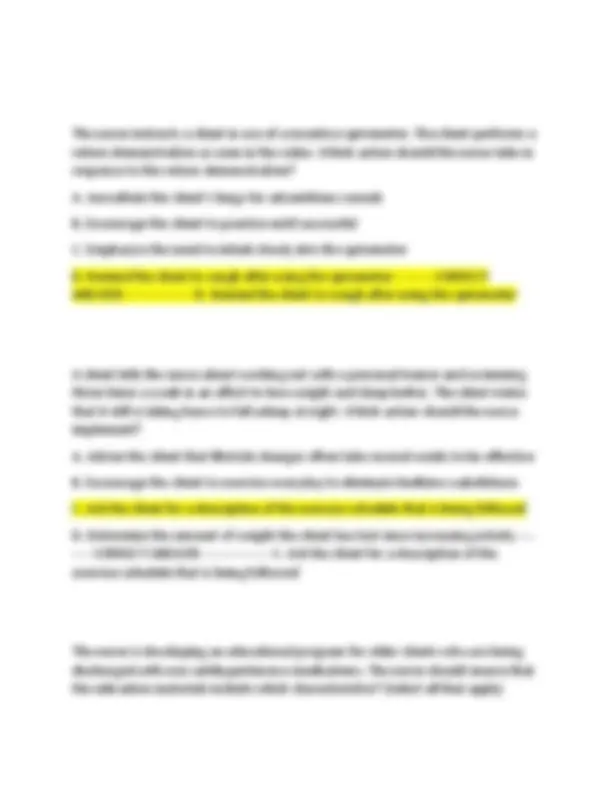
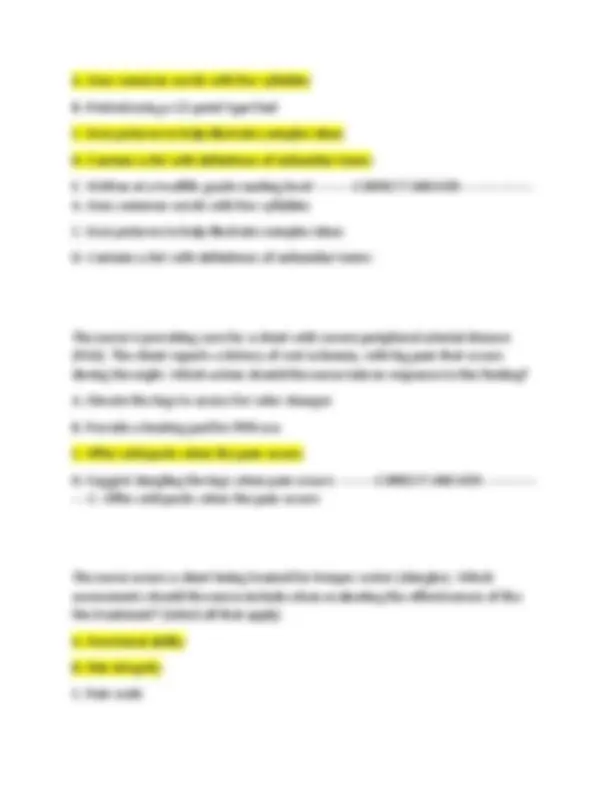
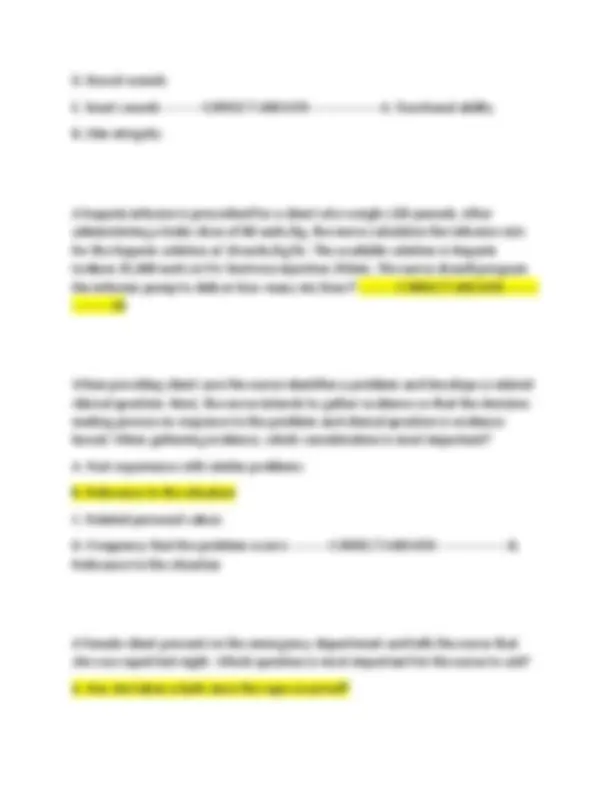
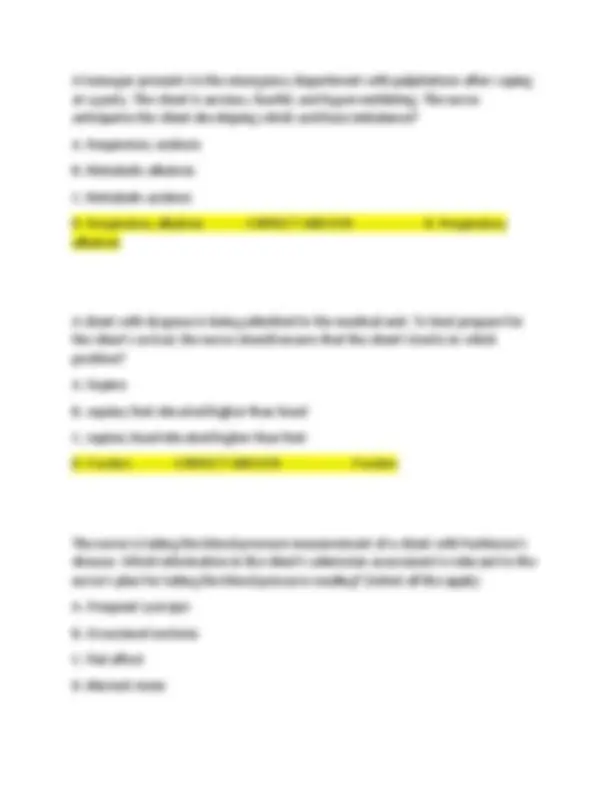
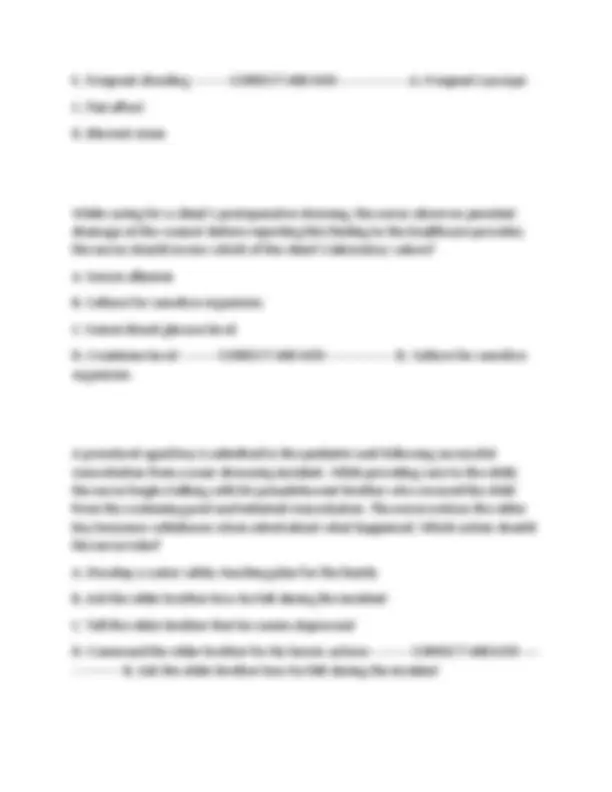
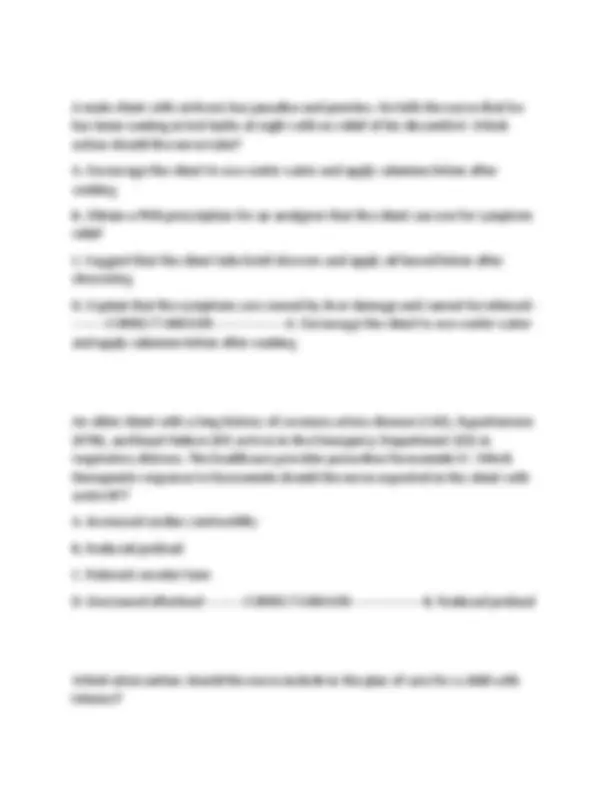
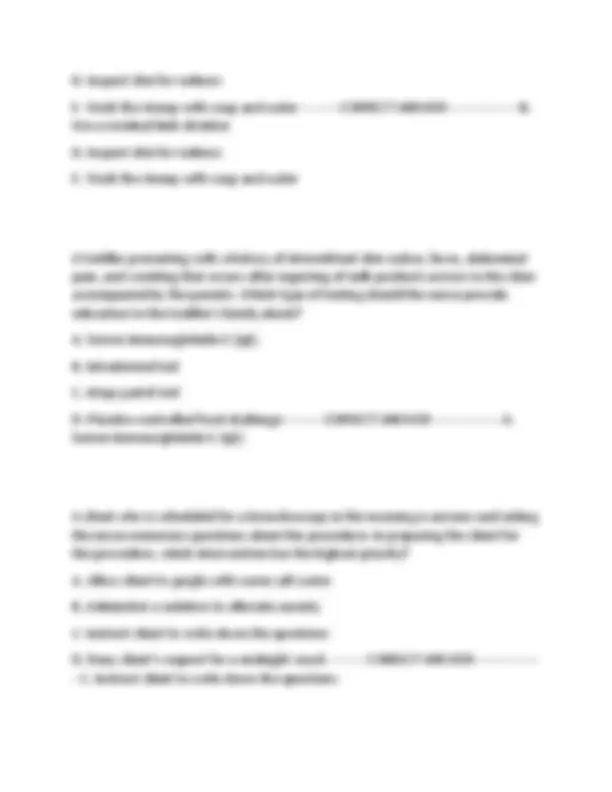
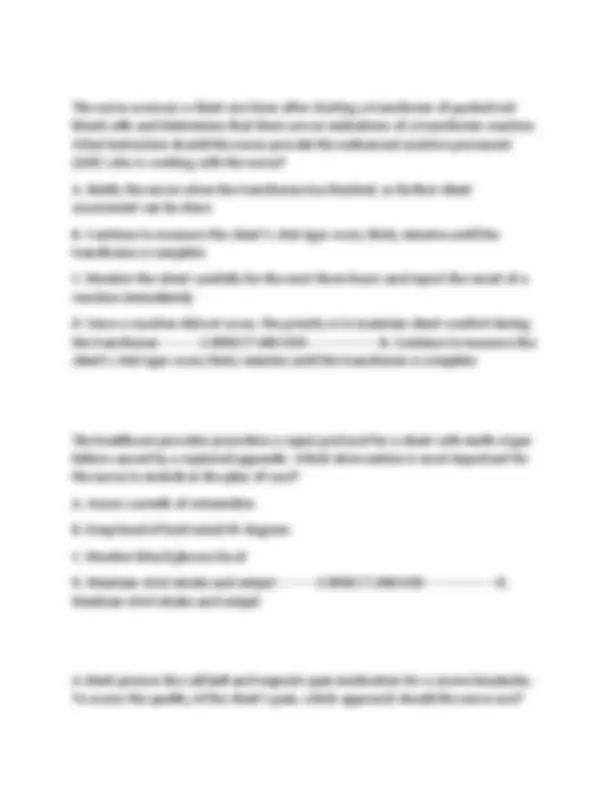
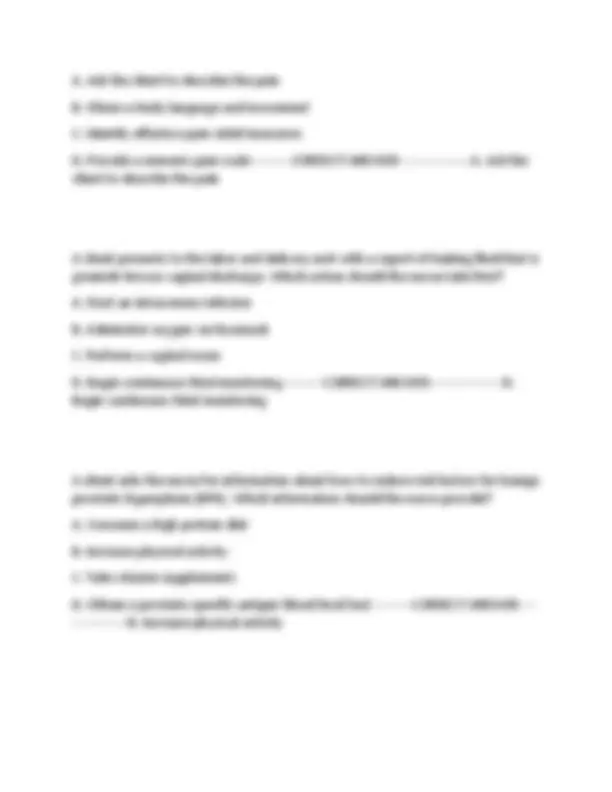
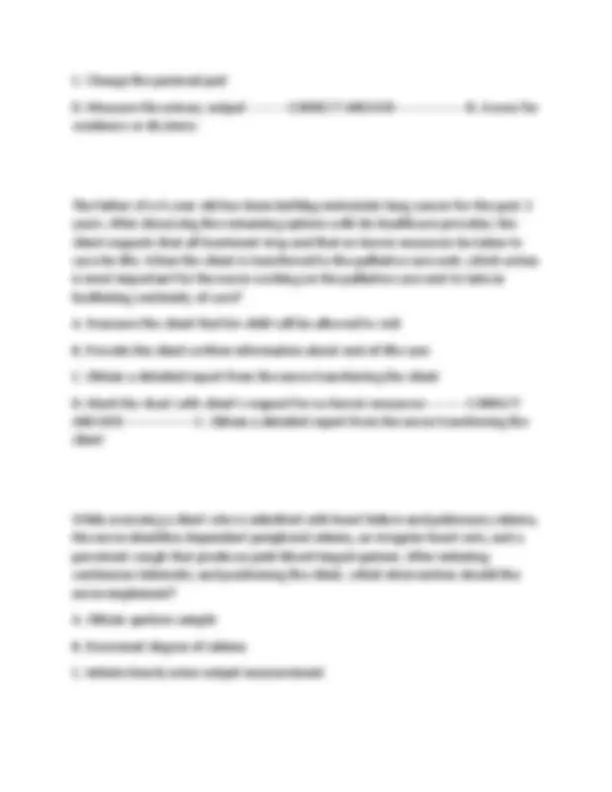
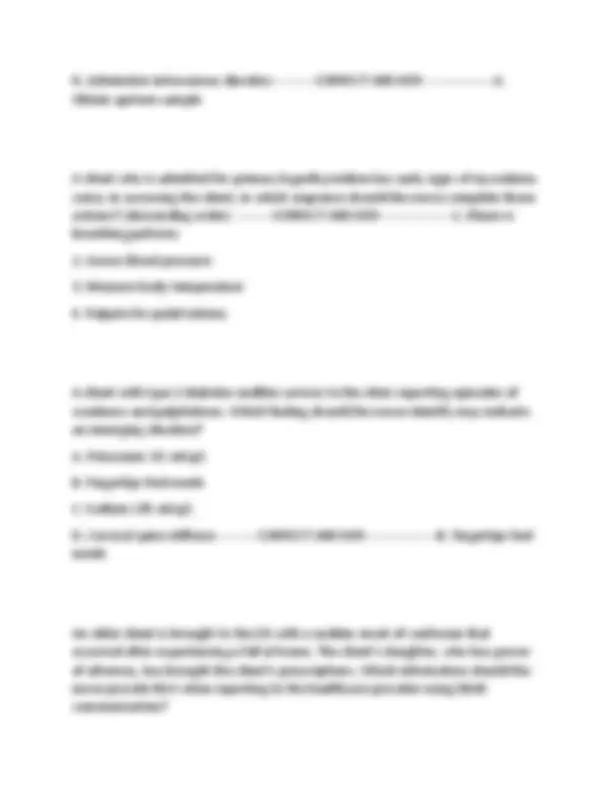
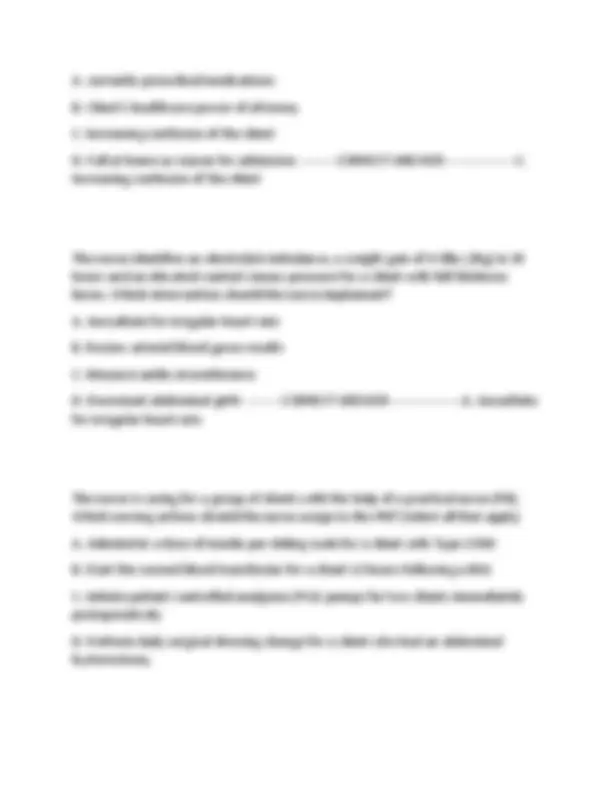
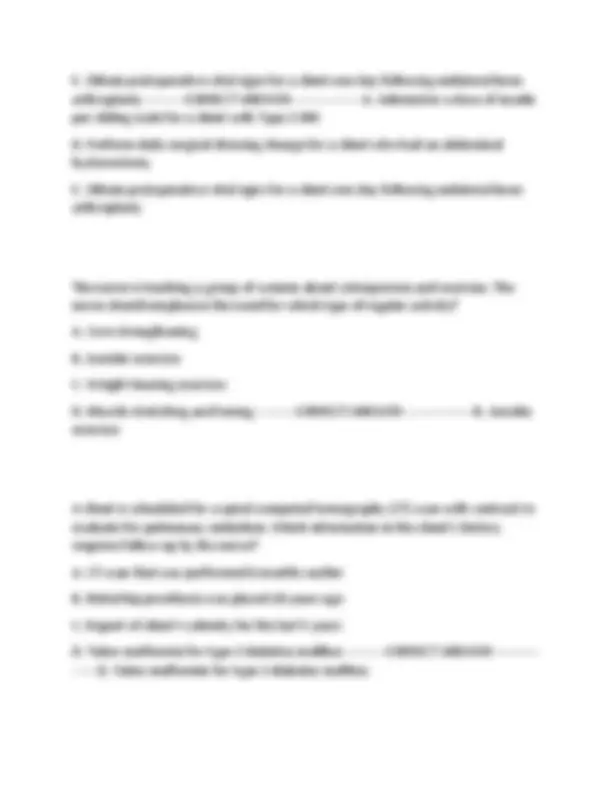
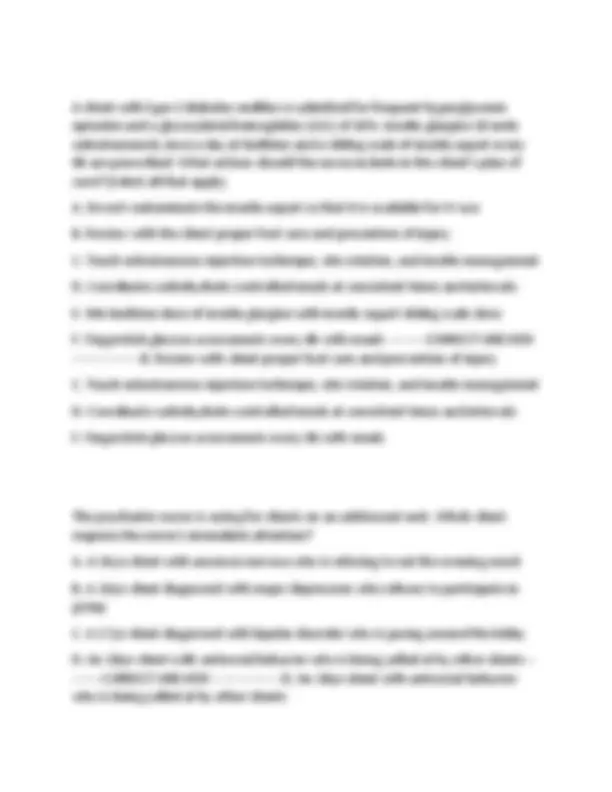
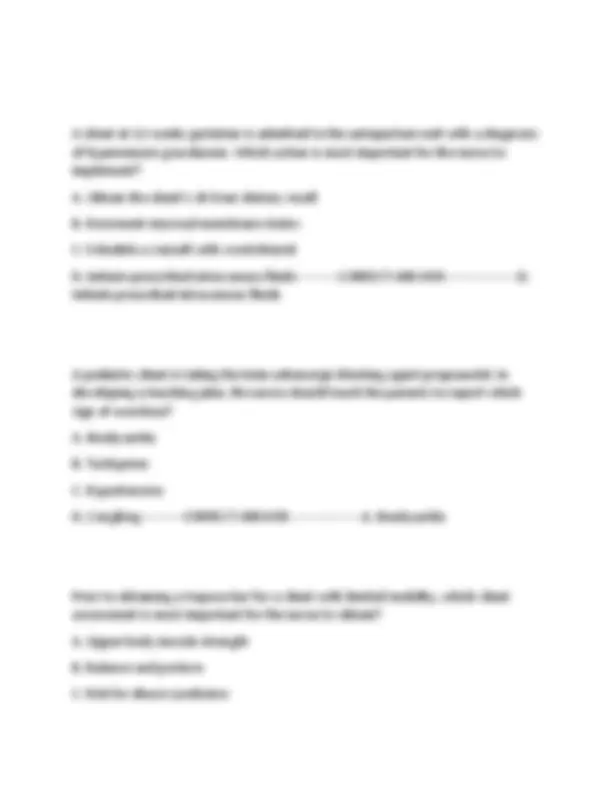
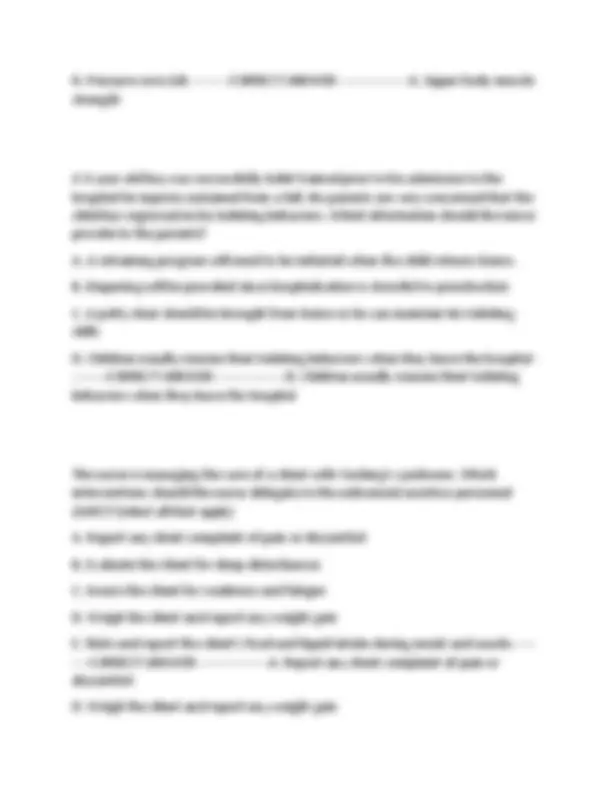
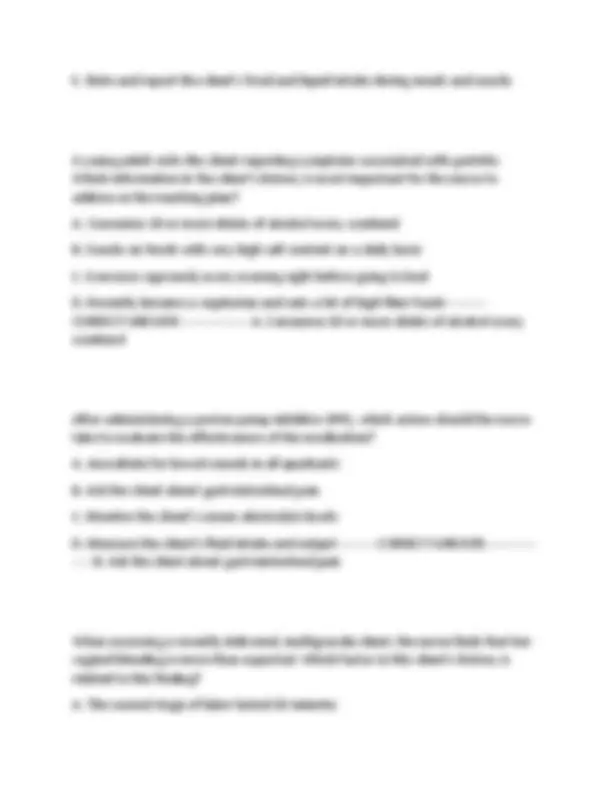
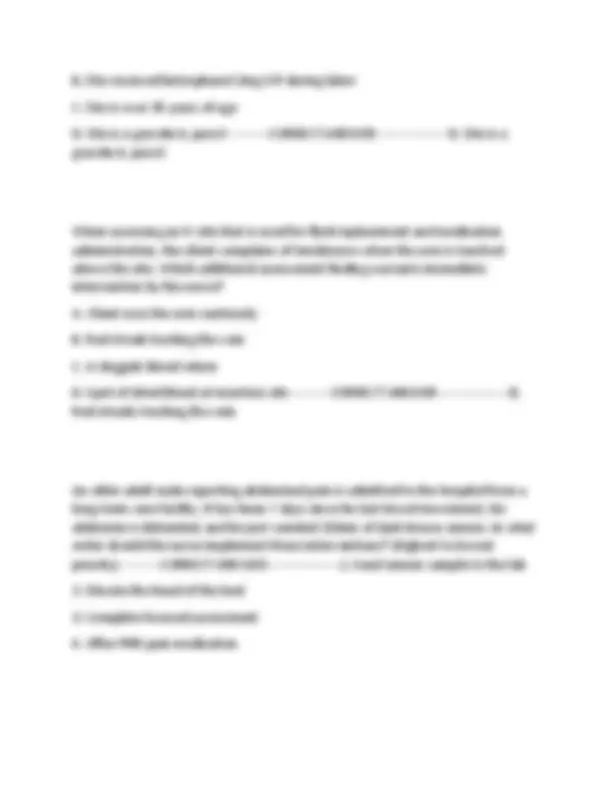
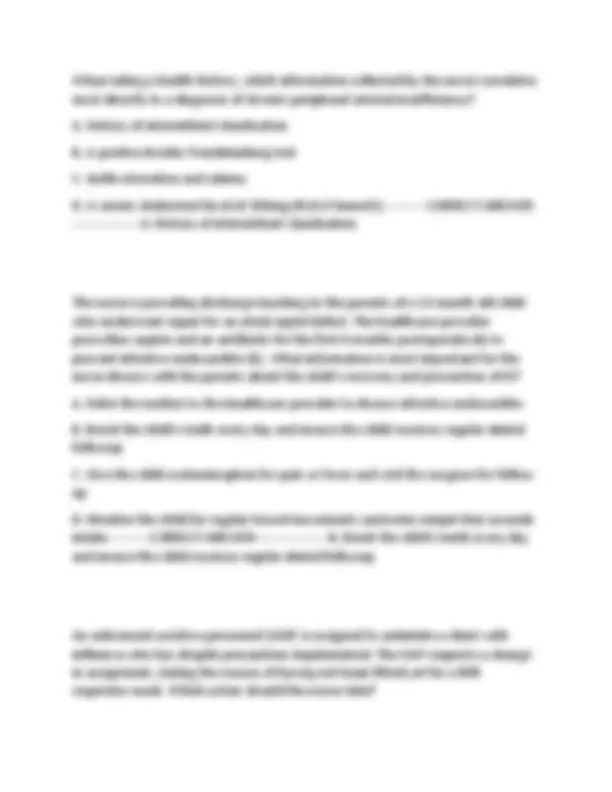
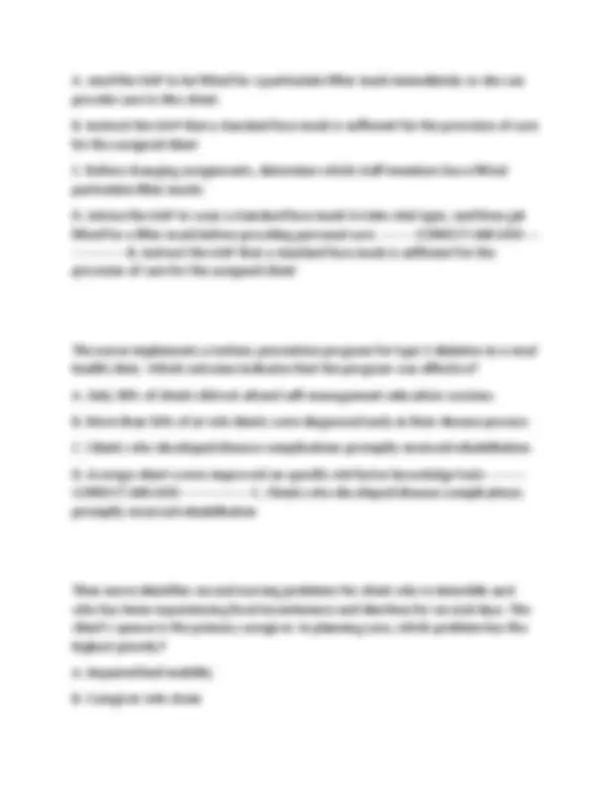
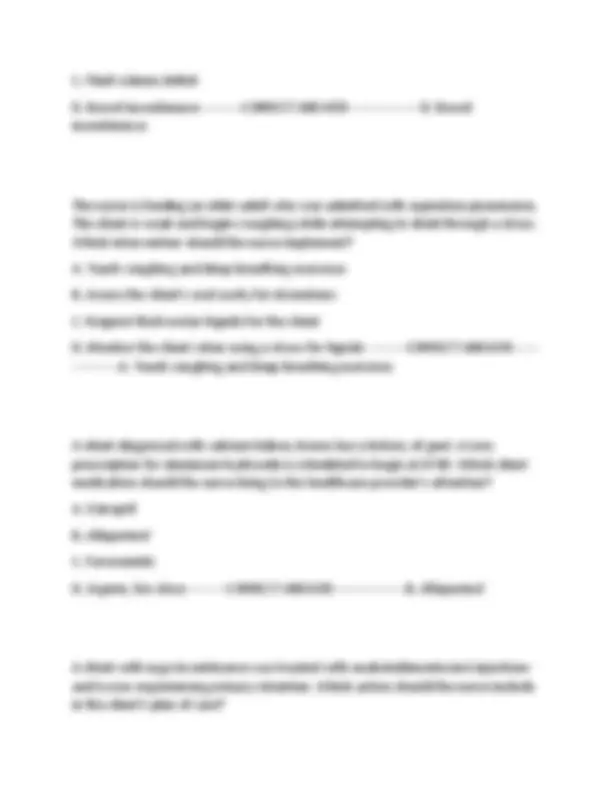
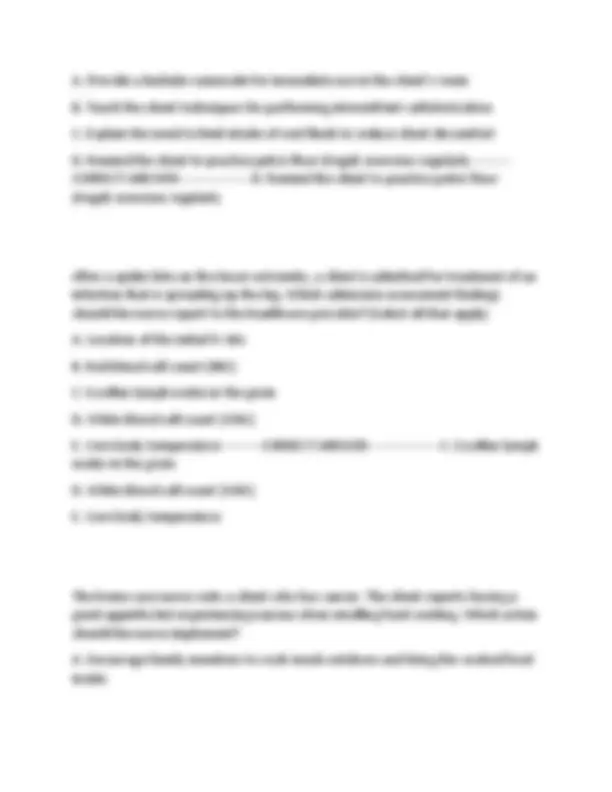
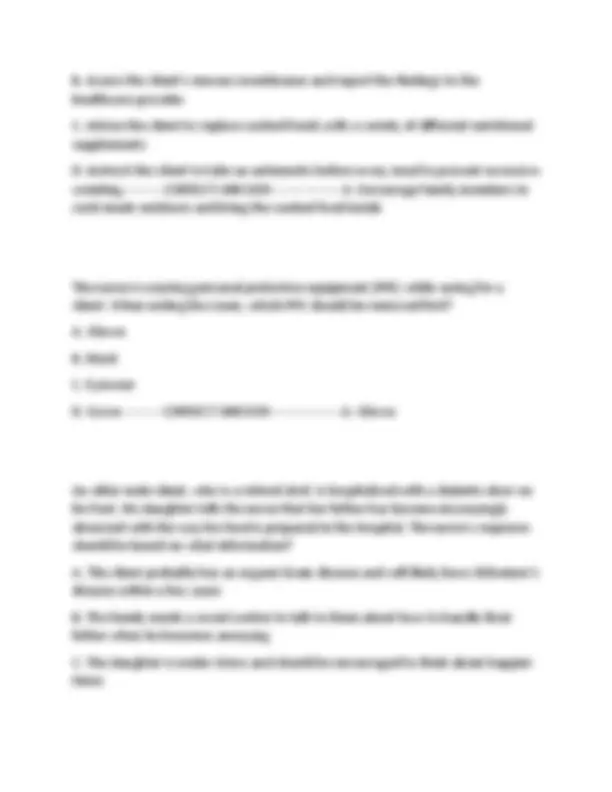
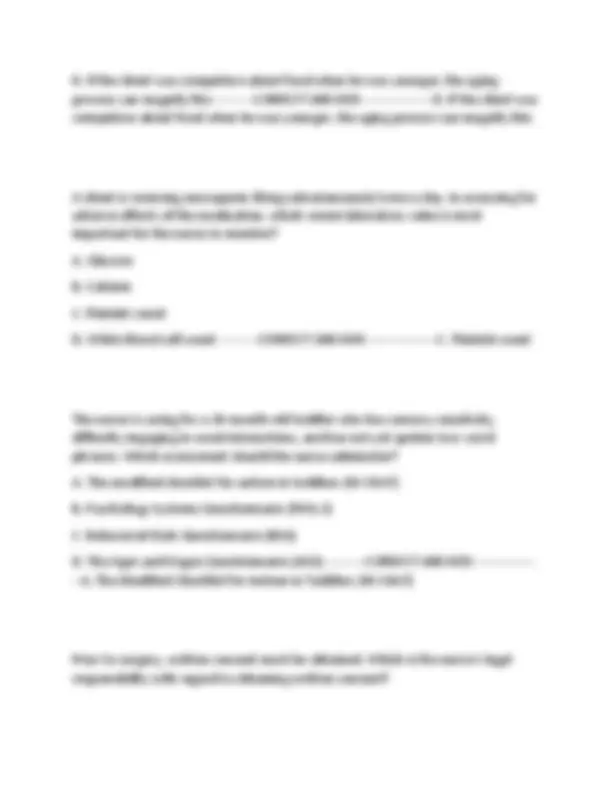
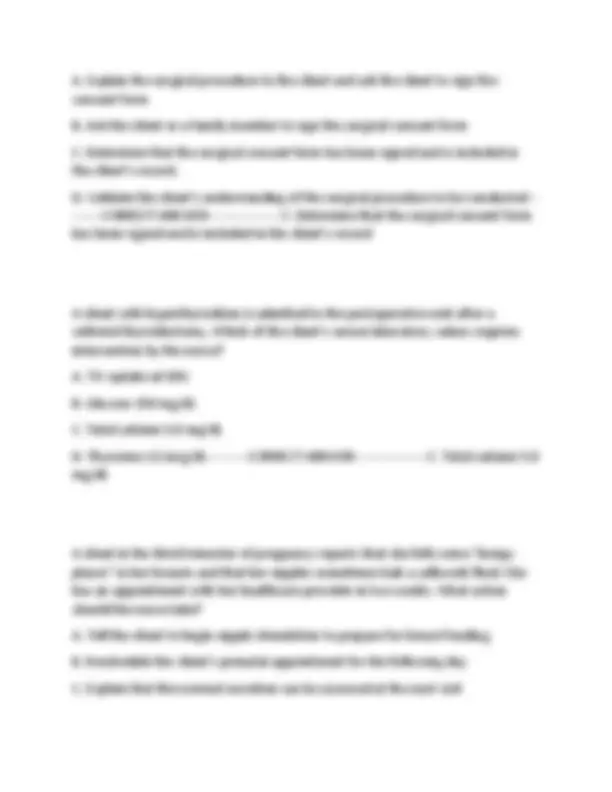
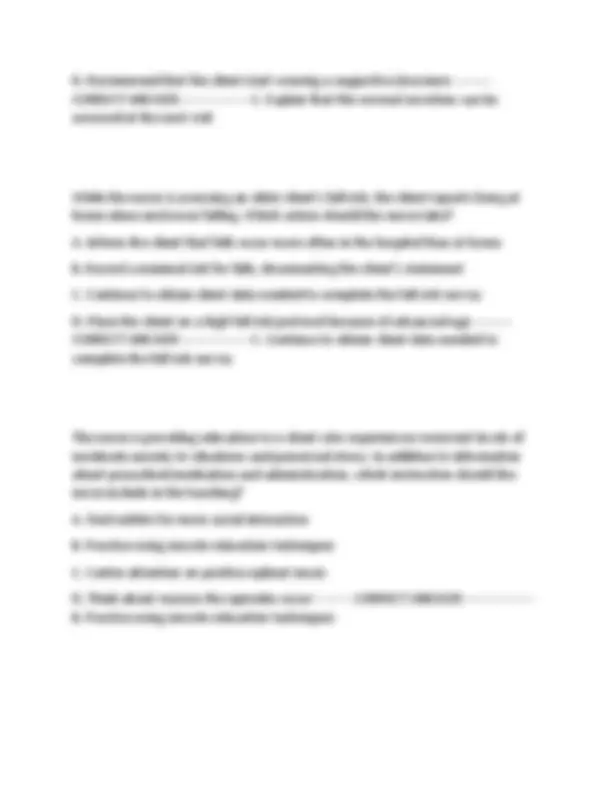
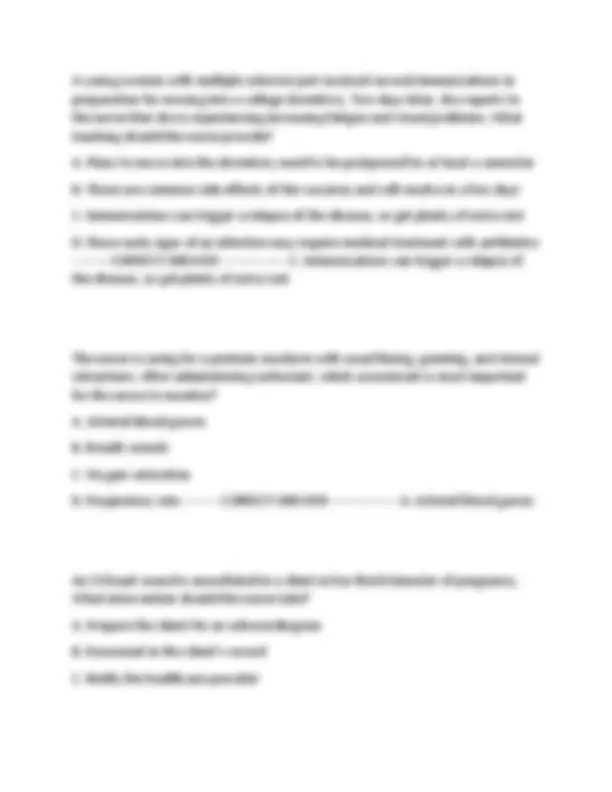
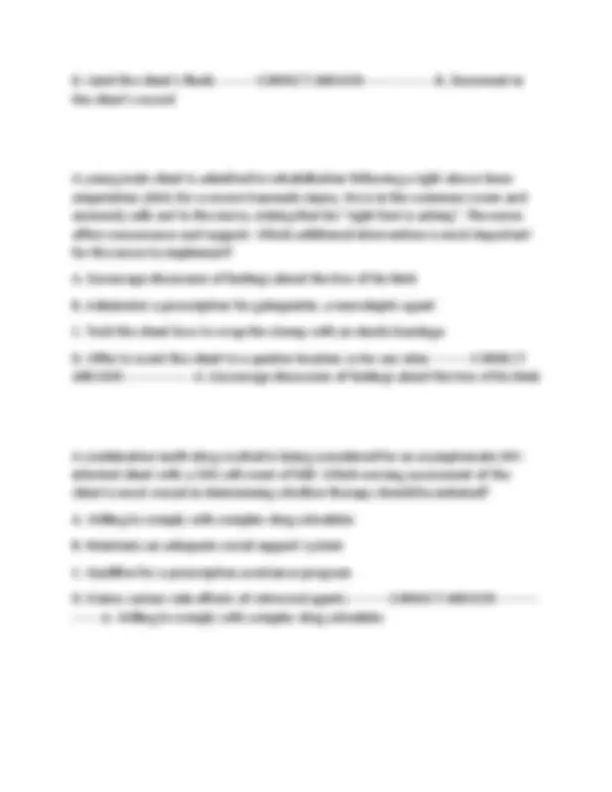
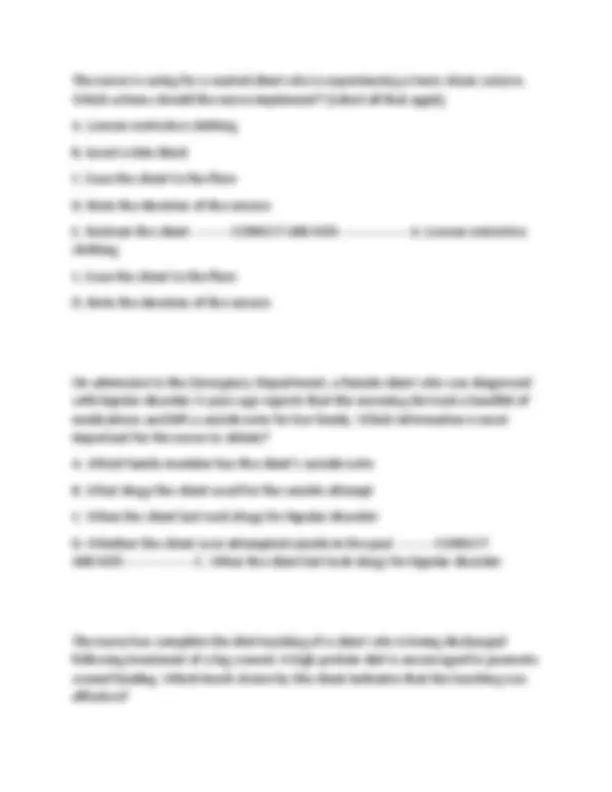
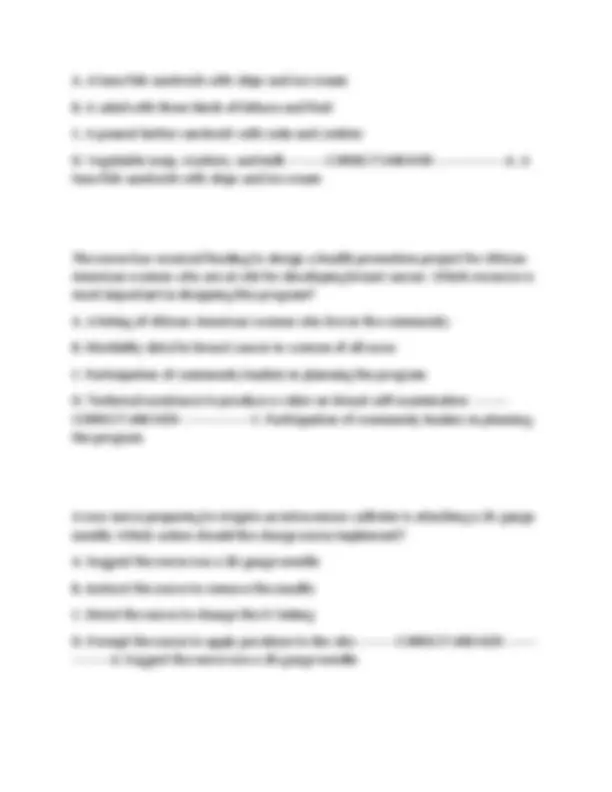
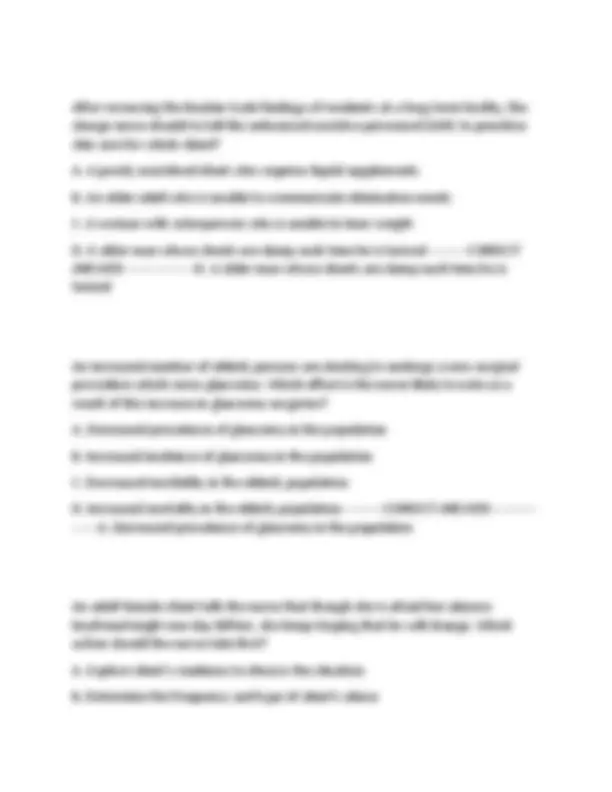
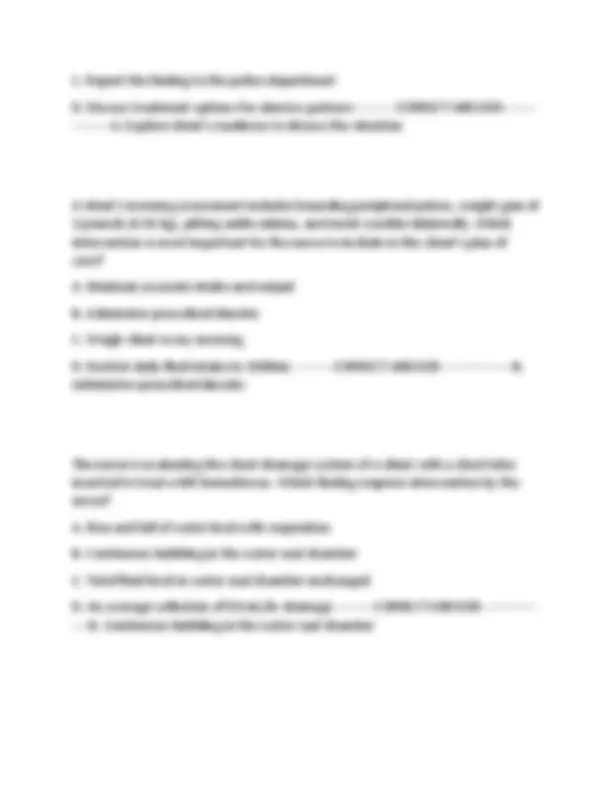
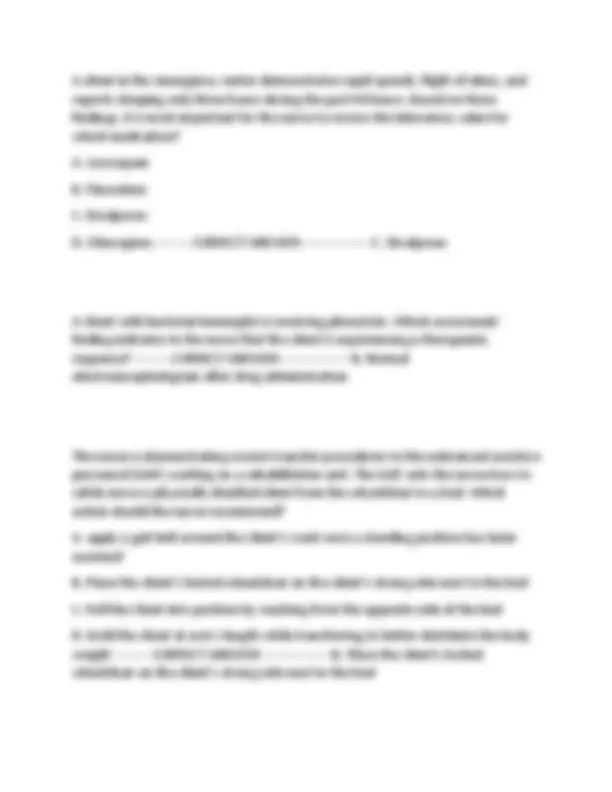
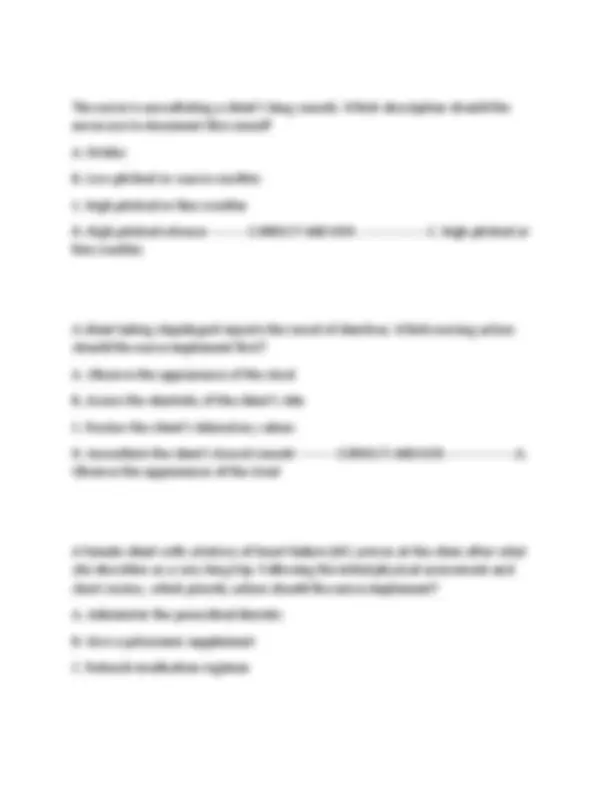
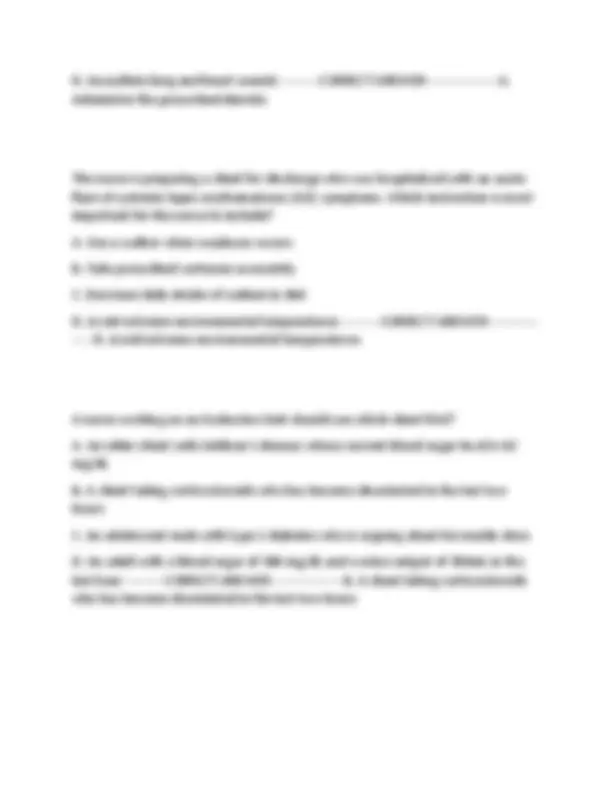
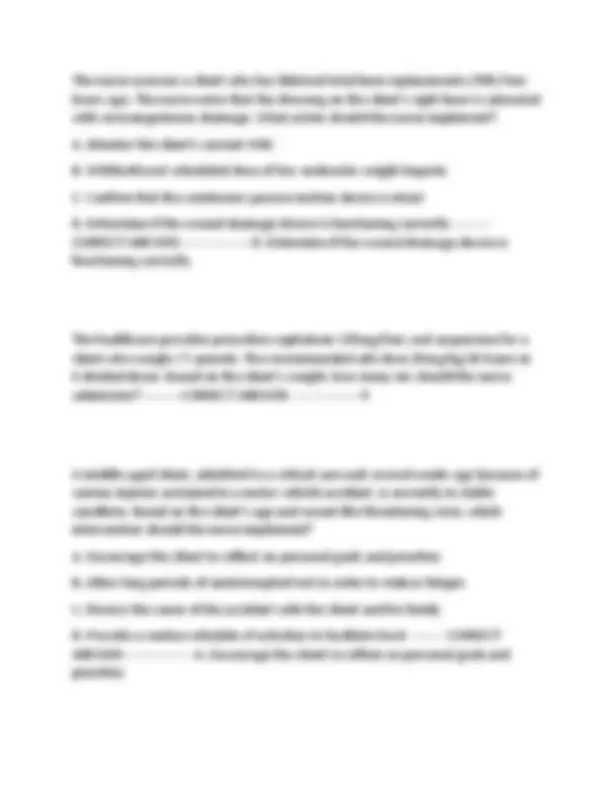
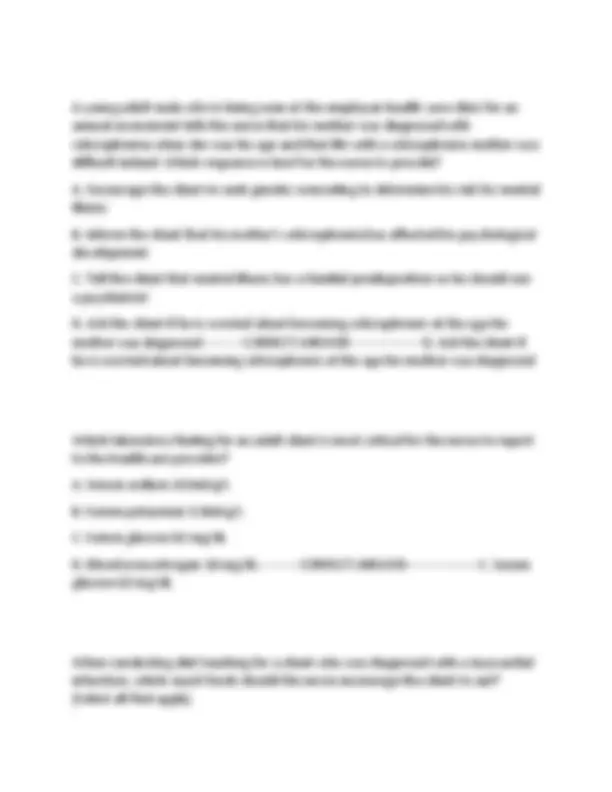
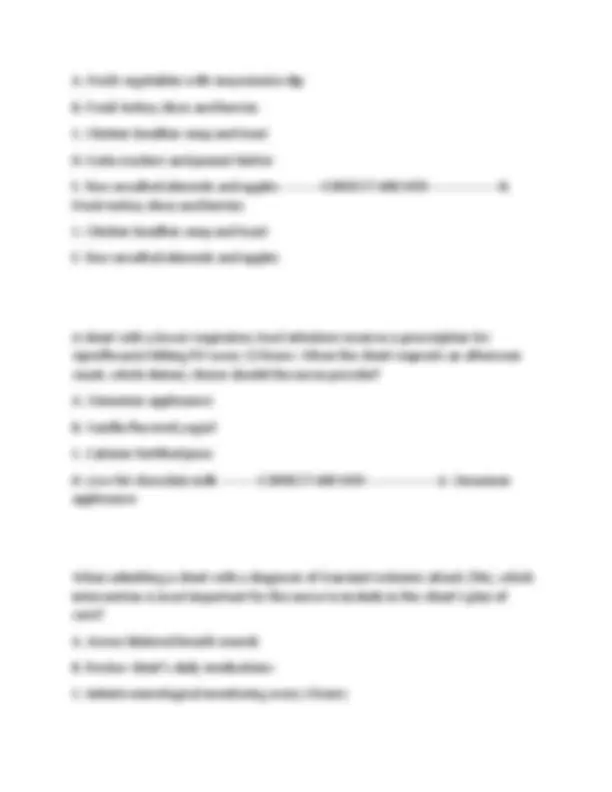
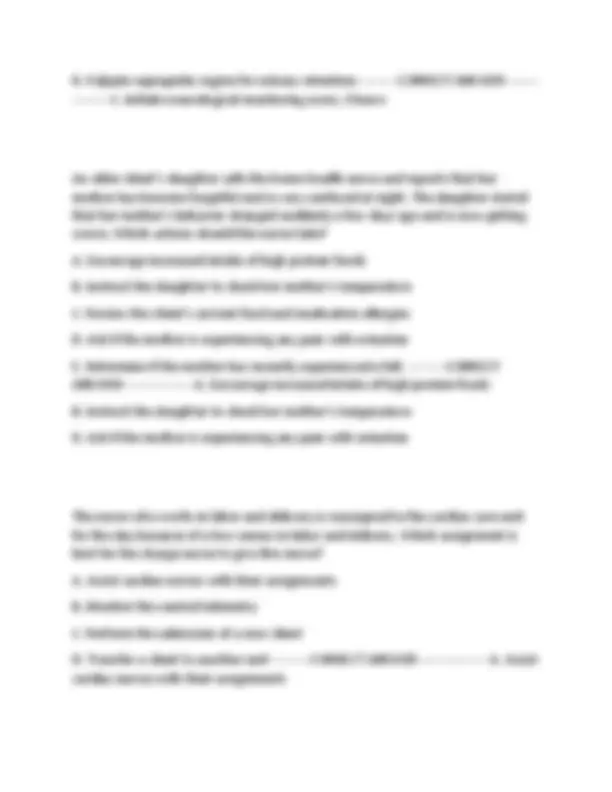
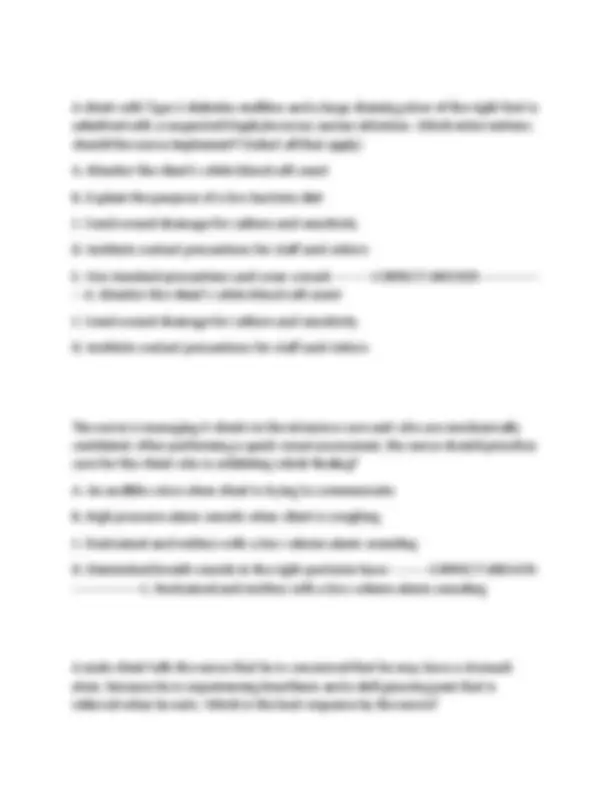
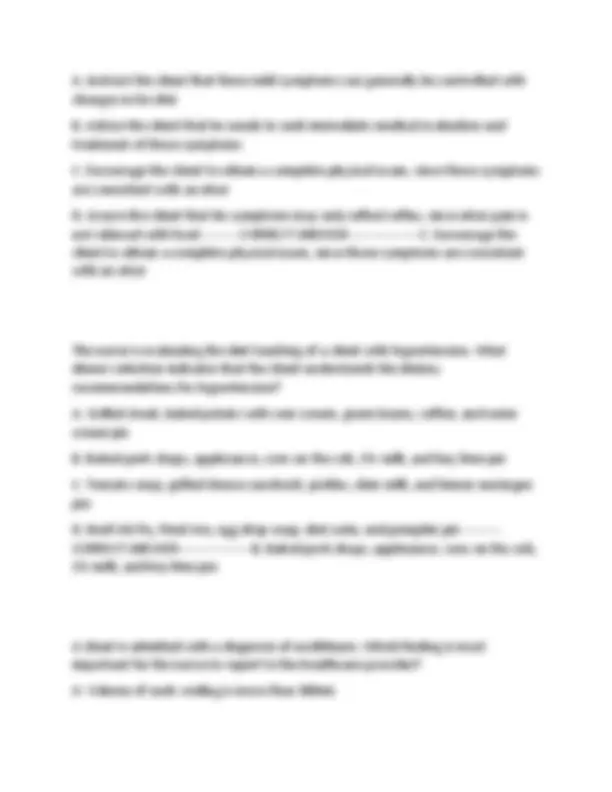
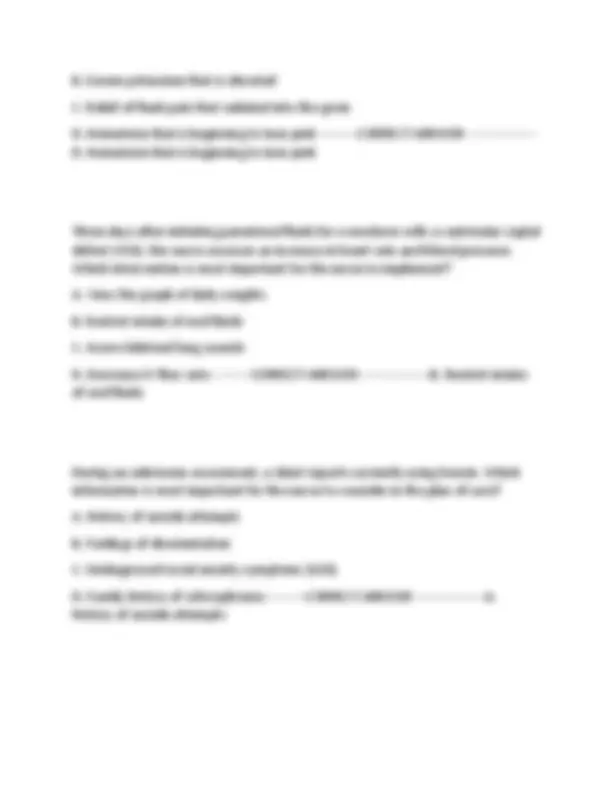
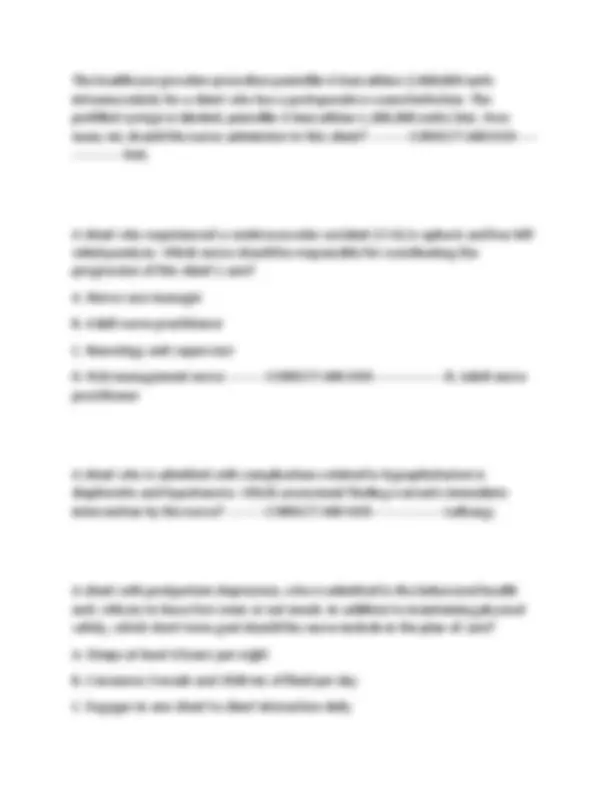
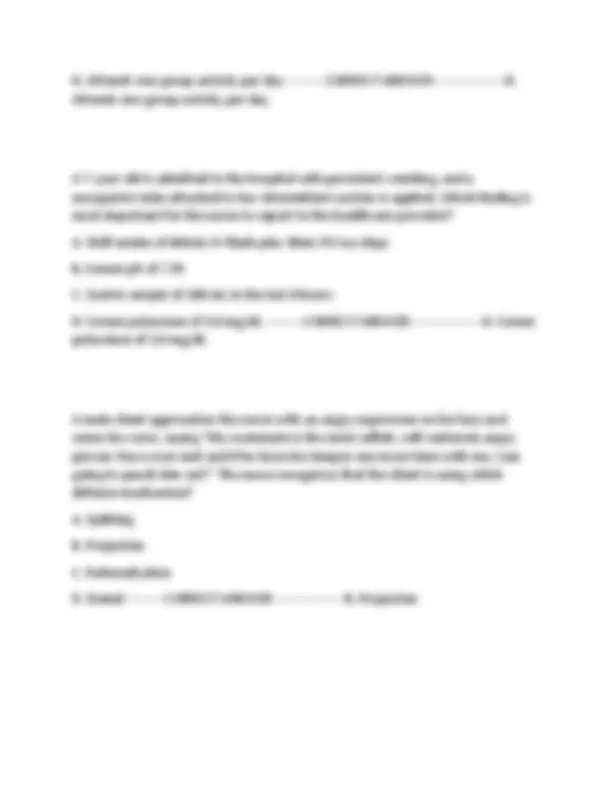
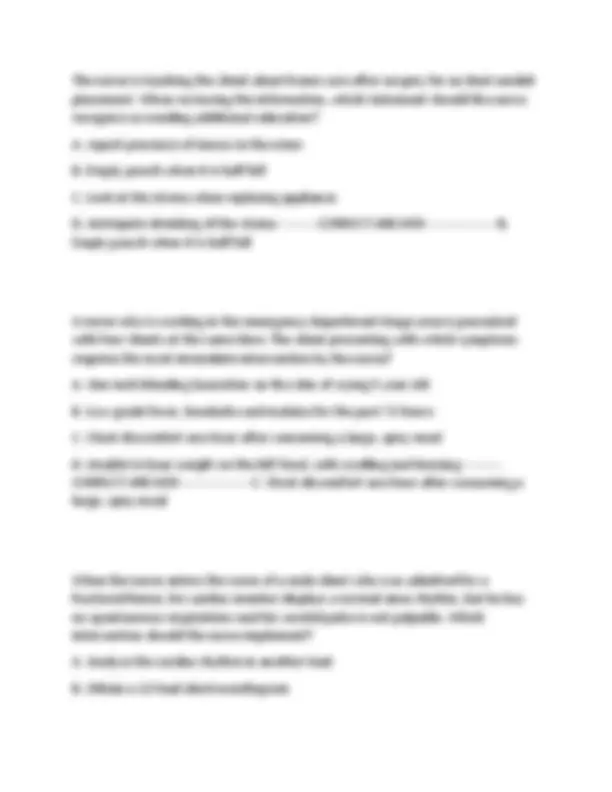
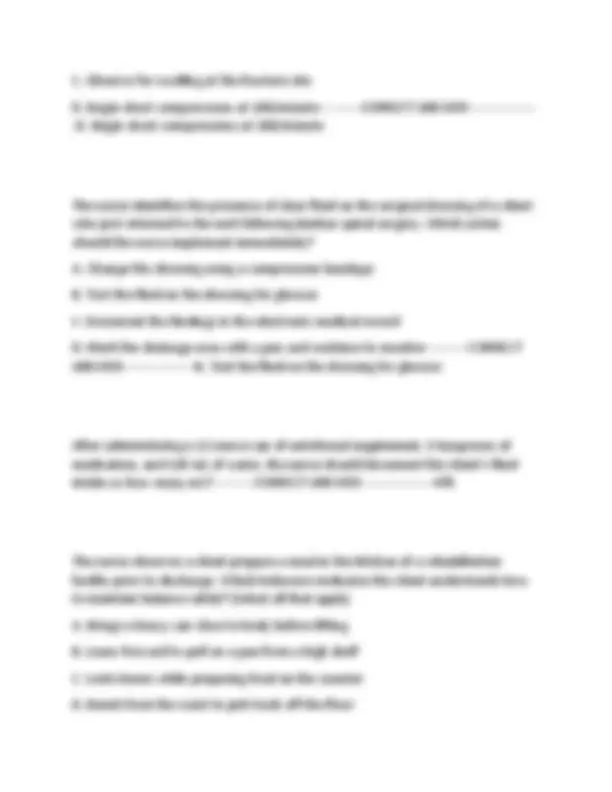
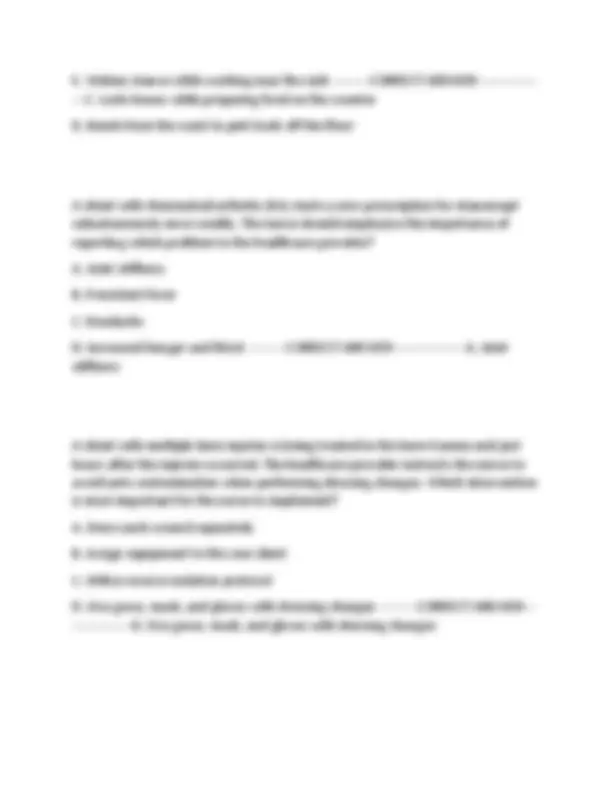
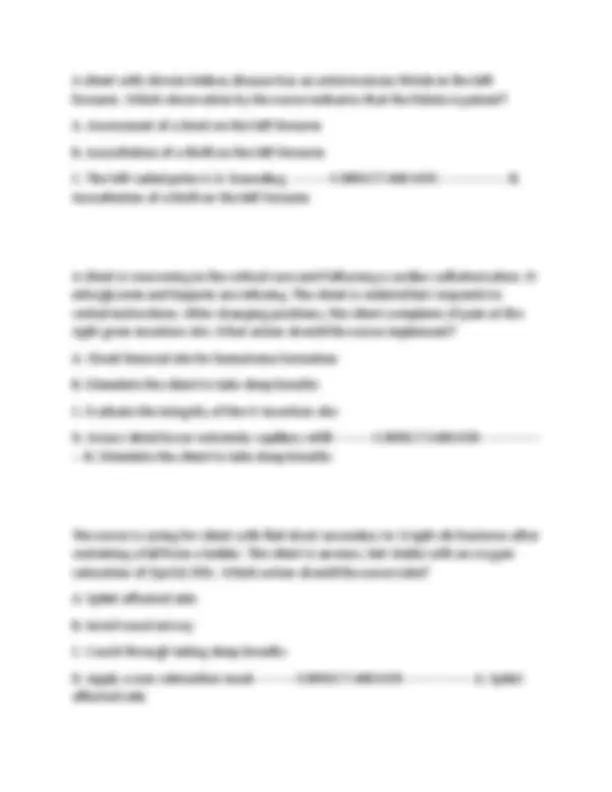
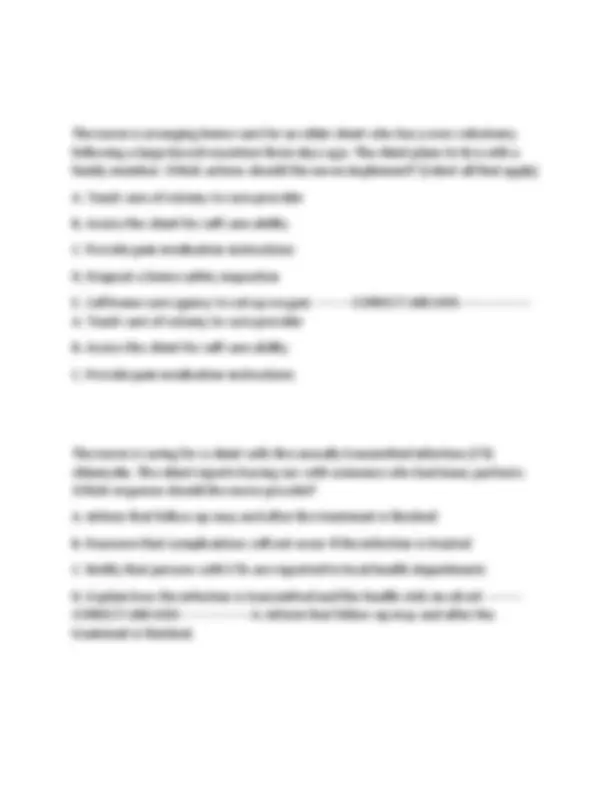
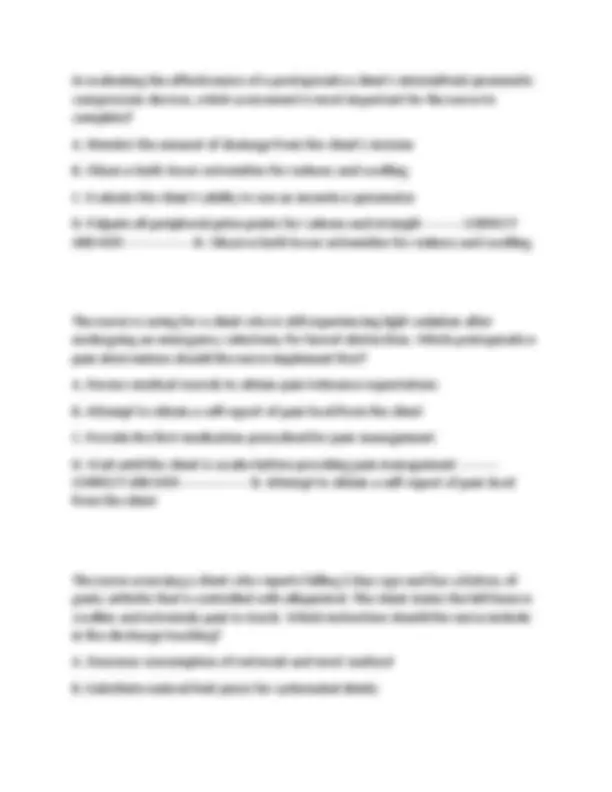
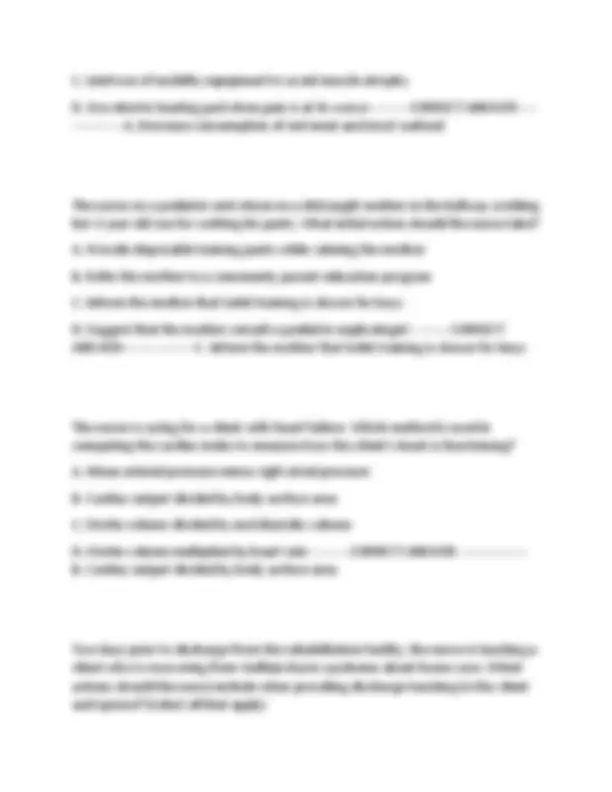
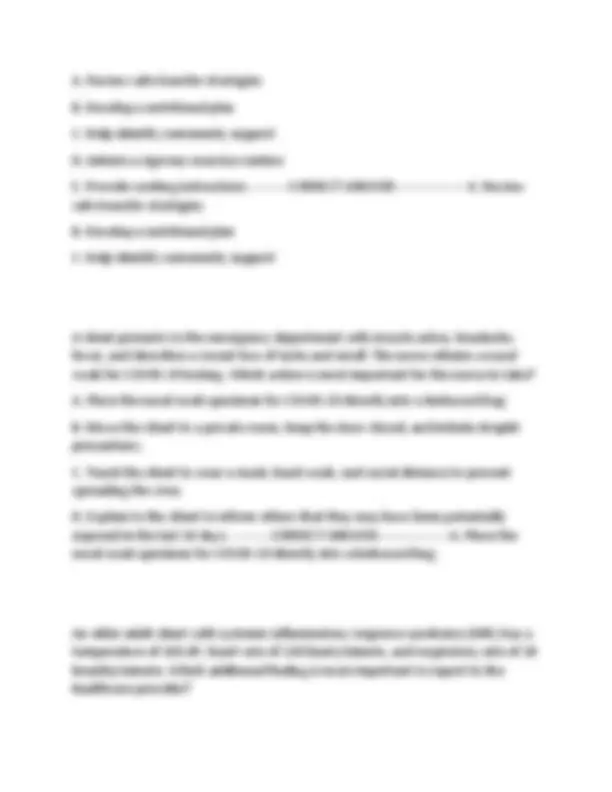
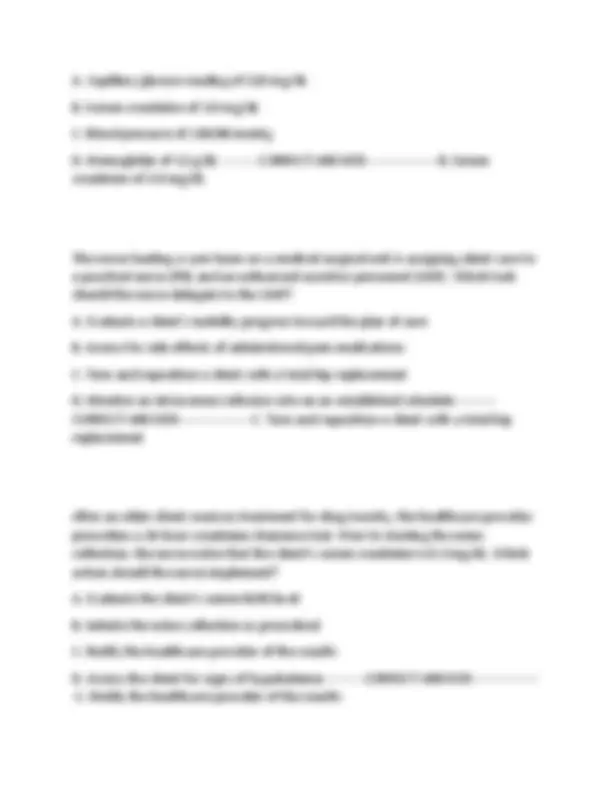
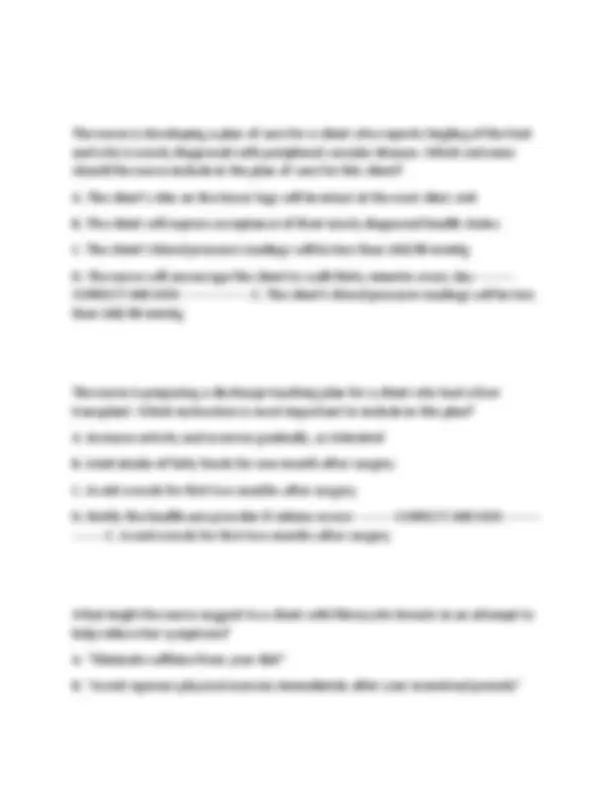
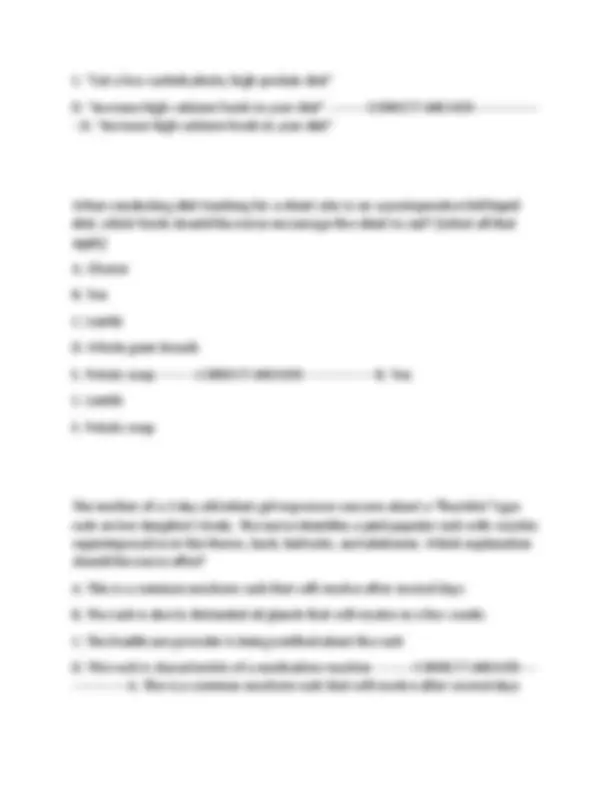
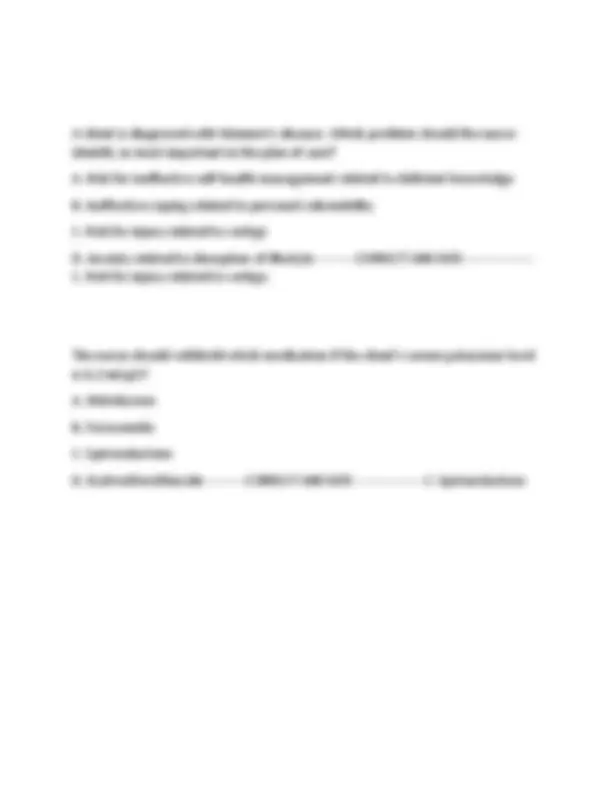


Study with the several resources on Docsity

Earn points by helping other students or get them with a premium plan


Prepare for your exams
Study with the several resources on Docsity

Earn points to download
Earn points by helping other students or get them with a premium plan
Community
Ask the community for help and clear up your study doubts
Discover the best universities in your country according to Docsity users
Free resources
Download our free guides on studying techniques, anxiety management strategies, and thesis advice from Docsity tutors
2025 HESI Exit Exam | Nightingale College | Featuring Comprehensive Nursing Concepts, Clinical Judgment, NCLEX Readiness, and Patient Care Management
Typology: Exams
1 / 64

This page cannot be seen from the preview
Don't miss anything!

























































An adult client is admitted to the emergency department after falling from the ladder. While waiting to have a computed tomography (CT) scan, the client requests something for a severe headache. When the nurse offers a prescribed dose of acetaminophen, the client asks for something stronger. Which intervention should the nurse implement? A. Review client's history for use of illicit drugs B. Explain the reason for using only non-narcotics C. Assess client's pupils for their reaction to light D. Request that the CT scan be done immediately ---------CORRECT ANSWER--------- --------B. Explain the reason for using only non-narcotics The nurse is caring for a client who has chronic obstructive pulmonary disease (COPD) and chest pain related to a recent fall. What nursing intervention requires the greatest caution when caring for a client with COPD? A. Monitoring telemetry and cardiac rhythm B. Assisting client to cough and deep breath C. Administering narcotics for pain relief D. Increasing the client's fluid intake ---------CORRECT ANSWER-----------------C. Administering narcotics for pain relief
The nurse is providing care for a client with schizophrenia who receives haloperidol decanoate 75mg IM every 4 weeks. The client begins developing a puckering and smacking of the lips and facial grimacing. Which intervention should the nurse implement? A. Monitor lying, sitting, and standing blood pressures B. Provide coaching in relaxation techniques C. Complete abnormal involuntary movement scale (AIMS) D. Discontinue all medications immediately ---------CORRECT ANSWER----------------- C. Complete abnormal involuntary movement scale (AIMS) Prolonged exposure to high concentrations of supplemental oxygen over several days can cause which pathophysiological effect? A. Disrupted surfactant production B. Metabolic acidosis C. Aphasia and memory loss D. Deep sleep or coma ---------CORRECT ANSWER-----------------A. Disrupted surfactant production A client who recently received a prescription for ramelteon to treat sleep deprivation reports experiencing several side effects since taking the drug. Which side effect should the nurse report to the healthcare provider? A. A change in the sleep-wake cycle B. Mild sedation C. Dizziness reported after initial dose D. Somnambulism ---------CORRECT ANSWER-----------------D. Somnambulism
A. Uses common words with few syllables B. Printed using a 12-point type font C. Uses pictures to help illustrate complex ideas D. Contains a list with definitions of unfamiliar terms E. Written at a twelfth-grade reading level ---------CORRECT ANSWER----------------- A. Uses common words with few syllables C. Uses pictures to help illustrate complex ideas D. Contains a list with definitions of unfamiliar terms The nurse is providing care for a client with severe peripheral arterial disease (PAD). The client reports a history of rest ischemia, with leg pain that occurs during the night. Which action should the nurse take in response to this finding? A. Elevate the legs to assess for color changes B. Provide a heating pad for PRN use C. Offer cold packs when the pain occurs D. Suggest dangling the legs when pain occurs ---------CORRECT ANSWER------------- ----C. Offer cold packs when the pain occurs The nurse assess a client being treated for Herpes zoster (shingles). Which assessments should the nurse include when evaluating the effectiveness of the the treatment? (Select all that apply) A. Functional ability B. Skin integrity C. Pain scale
D. Bowel sounds E. heart sounds ---------CORRECT ANSWER-----------------A. Functional ability B. Skin integrity A heparin infusion is prescribed for a client who weighs 220 pounds. After administering a bolus dose of 80 units/kg, the nurse calculates the infusion rate for the heparin solution at 18 units/kg/hr. The available solution is Heparin Sodium 25,000 units in 5% Dextrose injection 250mL. The nurse should program the infusion pump to deliver how many mL/hour? ---------CORRECT ANSWER-------- --------- 18 When providing client care the nurse identifies a problem and develops a related clinical question. Next, the nurse intends to gather evidence so that the decision- making process in response to the problem and clinical question is evidence- based. When gathering evidence, which consideration is most important? A. Past experience with similar problems B. Relevance to the situation C. Related personal values D. Frequency that the problem occurs ---------CORRECT ANSWER-----------------B. Relevance to the situation A female client presents in the emergency department and tells the nurse that she was raped last night. Which question is most important for the nurse to ask? A. Has she taken a bath since the rape occurred?
A child newly diagnosed with sickle cell anemia (SCA) is being discharged from the hospital. Which information is most important for the nurse to provide the parents prior to discharge? A. Instructions about how much fluid the child should drink daily. B. Signs of addiction to opioid pain medications C. Information about non-pharmaceutical pain relief measures D. Referral for social services for the child and family ---------CORRECT ANSWER---- -------------A. Instructions about how much fluid the child should drink daily To auscultate for a carotid bruit, the nurse places the stethoscope at what location. (Select the location on the image with a red dot). ---------CORRECT ANSWER-----------------I placed the red dot on the base of the neck on the right side After receiving report on an inpatient acute care unit, which client should the nurse assess first? A. The client with an obstruction of the large intestine who is experiencing abdominal distention B. The client who had surgery yesterday and is experiencing a paralytic ileus with absent bowel sounds C. The client with a small bowel obstruction who has a nasogastric tube that is draining greenish fluid D. The client with a bowel obstruction due to a volvulus who is experiencing abdominal rigidity ---------CORRECT ANSWER-----------------D. The client with a bowel obstruction due to a volvulus who is experiencing abdominal rigidity
A teenager presents to the emergency department with palpitations after vaping at a party. The client is anxious, fearful, and hyperventilating. The nurse anticipates the client developing which acid base imbalance? A. Respiratory acidosis B. Metabolic alkalosis C. Metabolic acidosis D. Respiratory alkalosis ---------CORRECT ANSWER-----------------D. Respiratory alkalosis A client with dyspnea is being admitted to the medical unit. To best prepare for the client's arrival, the nurse should ensure that the client's bed is in which position? A. Supine B. supine; feet elevated higher than head C. supine; head elevated higher than feet D. Fowlers ---------CORRECT ANSWER-----------------Fowlers The nurse is taking the blood pressure measurement of a client with Parkinson's disease. Which information in the client's admission assessment is relevant to the nurse's plan for taking the blood pressure reading? (Select all the apply) A. Frequent syncope B. Occasional nocturia C. Flat affect D. Blurred vision
A male client with cirrhosis has jaundice and pruritus. He tells the nurse that he has been soaking in hot baths at night with no relief of his discomfort. Which action should the nurse take? A. Encourage the client to use cooler water and apply calamine lotion after soaking B. Obtain a PRN prescription for an analgesic that the client can use for symptom relief C. Suggest that the client take brief showers and apply oil-based lotion after showering D. Explain that the symptoms are caused by liver damage and cannot be relieved - --------CORRECT ANSWER-----------------A. Encourage the client to use cooler water and apply calamine lotion after soaking An older client with a long history of coronary artery disease (CAD), hypertension (HTN), and heart failure (HF) arrives in the Emergency Department (ED) in respiratory distress. The healthcare provider prescribes furosemide IV. Which therapeutic response to furosemide should the nurse expected in the client with acute HF? A. Increased cardiac contractility B. Reduced preload C. Relaxed vascular tone D. Decreased afterload ---------CORRECT ANSWER-----------------B. Reduced preload Which intervention should the nurse include in the plan of care for a child with tetanus?
A. Encourage coughing and deep breathing B. Minimize the amount of stimuli in the room C. Reposition from side to side every hour D. Open window shades to provide natural light ---------CORRECT ANSWER----------- ------B. Minimize the amount of stimuli in the room An adolescent who was diagnosed with diabetes mellitus Type 1 at the age of 9, is admitted to the hospital in diabetic ketoacidosis. Which occurrence is the most likely cause of the ketoacidosis? A. Ate an extra peanut butter sandwich before gym class B. incorrectly administered too much insulin C. Had a cold and ear infection for the past two days D. Skipped eating lunch ---------CORRECT ANSWER-----------------C. Had a cold and ear infection for the past two days A client with a prescription for "do not resuscitate" (DNR) begins to manifest signs of impending death. After notifying the family of the client's status, what priority action should the nurse implement? A. The impending signs of death should be documented B. The client's status should be conveyed to the chaplain C. The client's need for pain medication should be determined D. The nurse manager should be updated on the client's status ---------CORRECT ANSWER-----------------C. The client's need for pain medication should be determined
D. Inspect skin for redness E. Wash the stump with soap and water ---------CORRECT ANSWER-----------------B. Use a residual limb shrinker D. Inspect skin for redness E. Wash the stump with soap and water A toddler presenting with a history of intermittent skin rashes, hives, abdominal pain, and vomiting that occurs after ingesting of milk products arrives to the clinic accompanied by the parents. Which type of testing should the nurse provide education to the toddler's family about? A. Serum immunoglobulin E (IgE) B. Intradermal test C. Atopy patch test D. Placebo-controlled food challenge ---------CORRECT ANSWER-----------------A. Serum immunoglobulin E (IgE) A client who is scheduled for a bronchoscopy in the morning is anxious and asking the nurse numerous questions about the procedure. In preparing the client for the procedure, which intervention has the highest priority? A. Allow client to gargle with warm salt water B. Administer a sedative to alleviate anxiety C. Instruct client to write down the questions D. Deny client's request for a midnight snack ---------CORRECT ANSWER--------------- --C. Instruct client to write down the questions
The nurse assesses a client one hour after starting a transfusion of packed red blood cells and determines that there are no indications of a transfusion reaction. What instruction should the nurse provide the unlicensed assistive personnel (UAP) who is working with the nurse? A. Notify the nurse when the transfusion has finished, so further client assessment can be done B. Continue to measure the client's vital signs every thirty minutes until the transfusion is complete C. Monitor the client carefully for the next three hours and report the onset of a reaction immediately D. Since a reaction did not occur, the priority is to maintain client comfort during the transfusion ---------CORRECT ANSWER-----------------B. Continue to measure the client's vital signs every thirty minutes until the transfusion is complete The healthcare provider prescribes a sepsis protocol for a client with multi-organ failure caused by a ruptured appendix. Which intervention is most important for the nurse to include in the plan of care? A. Assess warmth of extremities B. Keep head of bed raised 45 degrees C. Monitor blood glucose level D. Maintain strict intake and output ---------CORRECT ANSWER-----------------D. Maintain strict intake and output A client presses the call bell and requests pain medication for a severe headache. To assess the quality of the client's pain, which approach should the nurse use?
The healthcare provider prescribes a fluid challenge of 0.9% sodium chloride 1,000 mL to be infused intravenously over 4 hours. The IV administration set delivers 10gtt/mL. How many gtt/minute should the nurse regulate the infusion? (Round to the nearest whole number) ---------CORRECT ANSWER----------------- 42 gtt/min Following a cardiac catheterization and placement of a stent in the right coronary artery, the nurse administers prasugrel, a platelet inhibitor, to the client. To monitor for adverse effects from the medication, which assessment is most important for the nurse to include in this client's plan of care? A. observe color of urine B. Measure body temperature C. Assess skin turgor D. Check for pedal edema ---------CORRECT ANSWER-----------------A. Observe color of urine A client fell in the bathroom when left unattended by the unlicensed assistive personnel (UAP). Which information should the nurse include in the client's health record? A. The UAP left the client to assist another client B. The last time client was assisted to the bathroom C. The unit was understaffed when the client fell D. The client fell sustaining a fracture to the left hip ---------CORRECT ANSWER------ -----------D. The client fell sustaining a fracture to the left hip
The nurse is reviewing the diagnostic tests prescribed for a client with a positive skin test. Which subjective findings reported by the client supports the diagnosis of tuberculosis? A. Barking cough and vomiting B. Mucopurulent cough and night sweats C. Dry cough and chest tightness D. Chronic cough and fatty stools ---------CORRECT ANSWER-----------------B. Mucopurulent cough and night sweats In assessing a client with type 1 diabetes mellitus, the nurse notes that the client's respirations have changed from 16 breaths/min with a normal depth to 32 breaths/min and deep, and the client become lethargic. Which assessment data should the nurse obtain next? A. Temperature B. Breath sounds C. Blood glucose D. White blood cell count ---------CORRECT ANSWER-----------------C. Blood glucose A nurse receives report on a client who is four hours post-total abdominal hysterectomy. The previous nurse reports that it was necessary to change the client's perineal pad hourly and that it is again saturated. The previous nurse also reports that the client's urinary output has decreased. Which action should the nurse implement first? A. Evaluate the skin turgor B. Assess for weakness or dizziness
D. Administer intravenous diuretics ---------CORRECT ANSWER-----------------A. Obtain sputum sample A client who is admitted for primary hypothyroidism has early signs of myxedema coma. In assessing the client, in which sequence should the nurse complete these actions? (descending order) ---------CORRECT ANSWER-----------------1. Observe breathing patterns
A. currently prescribed medications B. Client's healthcare power of attorney C. Increasing confusion of the client D. Fall at home as reason for admission ---------CORRECT ANSWER-----------------C. Increasing confusion of the client The nurse identifies an electrolyte imbalance, a weight gain of 4.4lbs (2kg) in 24 hours and an elevated central venous pressure for a client with full thickness burns. Which intervention should the nurse implement? A. Auscultate for irregular heart rate B. Review arterial blood gases results C. Measure ankle circumference D. Document abdominal girth ---------CORRECT ANSWER-----------------A. Auscultate for irregular heart rate The nurse is caring for a group of clients with the help of a practical nurse (PN). Which nursing actions should the nurse assign to the PN? (Select all that apply) A. Administer a dose of insulin per sliding scale for a client with Type 2 DM B. Start the second blood transfusion for a client 12 hours following a BKA C. Initiate patient controlled analgesia (PCA) pumps for two clients immediately postoperatively D. Perform daily surgical dressing change for a client who had an abdominal hysterectomy